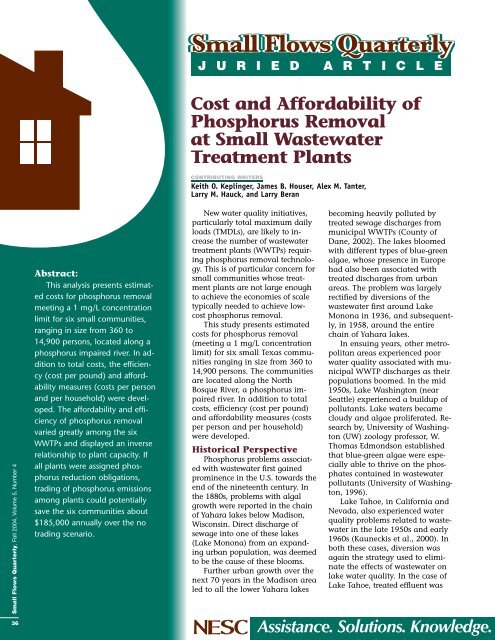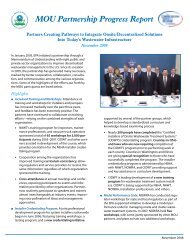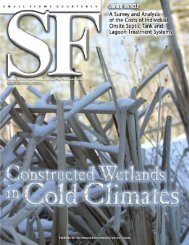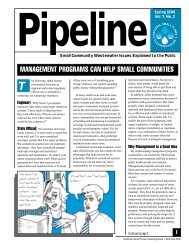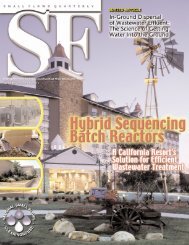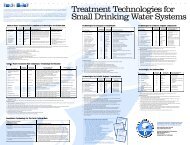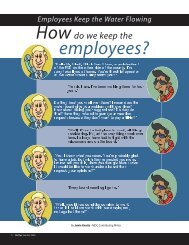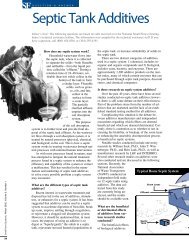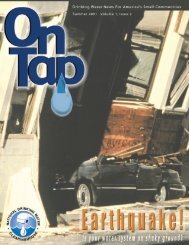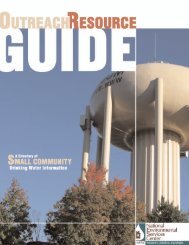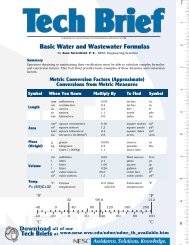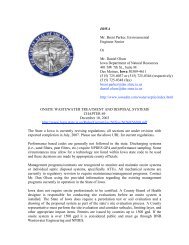Download - National Environmental Services Center - West Virginia ...
Download - National Environmental Services Center - West Virginia ...
Download - National Environmental Services Center - West Virginia ...
You also want an ePaper? Increase the reach of your titles
YUMPU automatically turns print PDFs into web optimized ePapers that Google loves.
Cost and Affordability of<br />
Phosphorus Removal<br />
at Small Wastewater<br />
Treatment Plants<br />
CONTRIBUTING WRITERS<br />
Keith O. Keplinger, James B. Houser, Alex M. Tanter,<br />
Larry M. Hauck, and Larry Beran<br />
Small Flows Quarterly, Fall 2004, Volume 5, Number 4<br />
Abstract:<br />
This analysis presents estimated<br />
costs for phosphorus removal<br />
meeting a 1 mg/L concentration<br />
limit for six small communities,<br />
ranging in size from 360 to<br />
14,900 persons, located along a<br />
phosphorus impaired river. In addition<br />
to total costs, the efficiency<br />
(cost per pound) and affordability<br />
measures (costs per person<br />
and per household) were developed.<br />
The affordability and efficiency<br />
of phosphorus removal<br />
varied greatly among the six<br />
WWTPs and displayed an inverse<br />
relationship to plant capacity. If<br />
all plants were assigned phosphorus<br />
reduction obligations,<br />
trading of phosphorus emissions<br />
among plants could potentially<br />
save the six communities about<br />
$185,000 annually over the no<br />
trading scenario.<br />
New water quality initiatives,<br />
particularly total maximum daily<br />
loads (TMDLs), are likely to increase<br />
the number of wastewater<br />
treatment plants (WWTPs) requiring<br />
phosphorus removal technology.<br />
This is of particular concern for<br />
small communities whose treatment<br />
plants are not large enough<br />
to achieve the economies of scale<br />
typically needed to achieve lowcost<br />
phosphorus removal.<br />
This study presents estimated<br />
costs for phosphorus removal<br />
(meeting a 1 mg/L concentration<br />
limit) for six small Texas communities<br />
ranging in size from 360 to<br />
14,900 persons. The communities<br />
are located along the North<br />
Bosque River, a phosphorus impaired<br />
river. In addition to total<br />
costs, efficiency (cost per pound)<br />
and affordability measures (costs<br />
per person and per household)<br />
were developed.<br />
Historical Perspective<br />
Phosphorus problems associated<br />
with wastewater first gained<br />
prominence in the U.S. towards the<br />
end of the nineteenth century. In<br />
the 1880s, problems with algal<br />
growth were reported in the chain<br />
of Yahara lakes below Madison,<br />
Wisconsin. Direct discharge of<br />
sewage into one of these lakes<br />
(Lake Monona) from an expanding<br />
urban population, was deemed<br />
to be the cause of these blooms.<br />
Further urban growth over the<br />
next 70 years in the Madison area<br />
led to all the lower Yahara lakes<br />
becoming heavily polluted by<br />
treated sewage discharges from<br />
municipal WWTPs (County of<br />
Dane, 2002). The lakes bloomed<br />
with different types of blue-green<br />
algae, whose presence in Europe<br />
had also been associated with<br />
treated discharges from urban<br />
areas. The problem was largely<br />
rectified by diversions of the<br />
wastewater first around Lake<br />
Monona in 1936, and subsequently,<br />
in 1958, around the entire<br />
chain of Yahara lakes.<br />
In ensuing years, other metropolitan<br />
areas experienced poor<br />
water quality associated with municipal<br />
WWTP discharges as their<br />
populations boomed. In the mid<br />
1950s, Lake Washington (near<br />
Seattle) experienced a buildup of<br />
pollutants. Lake waters became<br />
cloudy and algae proliferated. Research<br />
by, University of Washington<br />
(UW) zoology professor, W.<br />
Thomas Edmondson established<br />
that blue-green algae were especially<br />
able to thrive on the phosphates<br />
contained in wastewater<br />
pollutants (University of Washington,<br />
1996).<br />
Lake Tahoe, in California and<br />
Nevada, also experienced water<br />
quality problems related to wastewater<br />
in the late 1950s and early<br />
1960s (Kauneckis et al., 2000). In<br />
both these cases, diversion was<br />
again the strategy used to eliminate<br />
the effects of wastewater on<br />
lake water quality. In the case of<br />
Lake Tahoe, treated effluent was<br />
36


